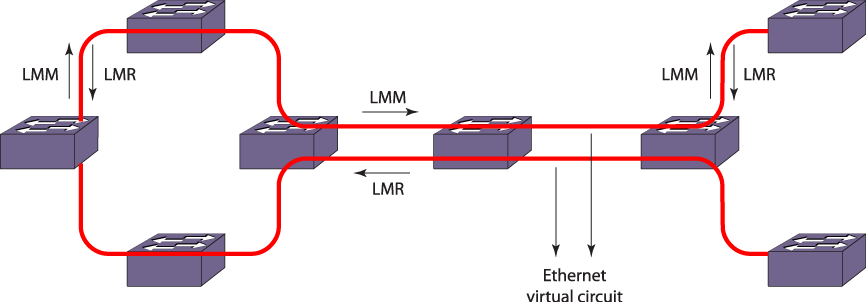Single-Ended Frame-Loss Measurements
Single-ended frame-loss measurement facilitates on-demand OAM. MEPs
carry out frame-loss measurments by sending frames to peer MEPs with frame-loss
measurement request information and receiving frames with frame-loss measurement reply
information. This Y_1731 frame-loss measurement depends on VLAN statistics.
The PDU for single-ended frame-loss measurement requests is Loss
Measurement Message (LMM). The PDU for single-ended frame-loss measurement reply is Loss
Measurement Reply (LMR). Two-Way Frame-Loss Measurement shows the
transmission of LMM and LMR for frame-loss measurement.
Two-Way Frame-Loss Measurement
A MEP maintains two local counters for each peer MEP it is monitoring
for frame-loss:
- TxFCl—in-profile data frames transmitted to the peer
MEP.
- RxFCl—in-profile data frames received from the peer
MEP.
For an on-demand loss measurement, a MEP periodically transmits
LMM frames with TxFCf (value of the local TxFCl counter at the time
of LMM frame transmission). Upon receiving a valid LMM frame, a
MEP sends an LMR frame to the requesting MEP. (Valid LMM frames
have a valid MD level and a destination MAC address equal to the
receiving MEP's MAC address.)
An LMR frame contains the following values:
- TxFCf—TxFCf value copied from the LMM frame.
- RxFCf—RxFCl value when the LMM frame was received.
- TxFCb—TxFCl value when the LMR frame was transmitted.
Upon receiving an LMR frame, a MEP uses the following values
to make near-end and far-end loss measurements:
- Received LMR frame's TxFCf, RxFCf, and TxFCb values, and
local counter RxFCl value at the time this LMR frame was received. These values
are represented as TxFCf[tc], RxFCf[tc], TxFCb[tc], and RxFCl[tc]; where tc is
the time the current reply frame was received.
- Previous LMR frame's TxFCf, RxFCf, and TxFCb values, and
local counter RxFCl value at the time the previous LMR frame was received. These
values are represented as TxFCf[tp], RxFCf[tp], TxFCb[tp], and RxFCl[tp],where
tp is the time the previous reply frame was received.
Far-End Frame Loss = (TxFCf[tc] – TxFCf[tp]) – (RxFCf[tc] – RxFCf[tp])
Near-End Frame Loss = (TxFCb[tc] – TxFCb[tp]) – (RxFCl[tc] –
RxFCl[tp])


 Print
this page
Print
this page Email this topic
Email this topic Feedback
Feedback